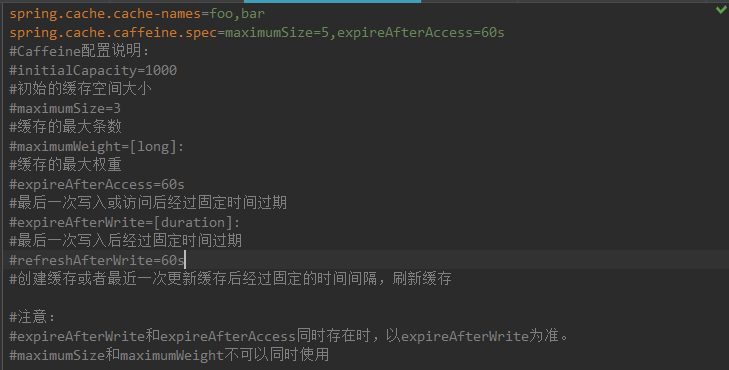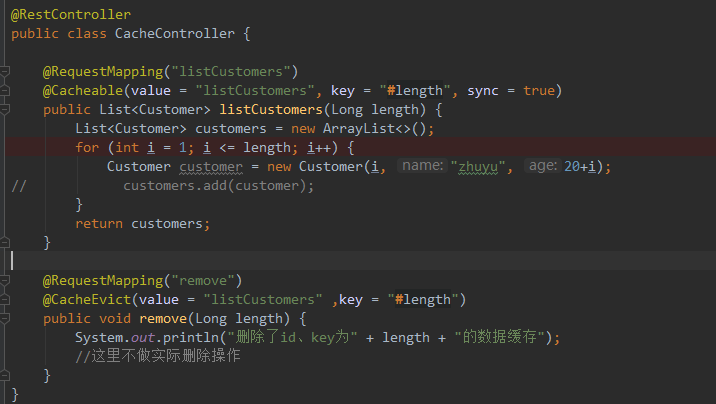1.今天我们来学习一下Coffeine,一个高性能的 Java 缓存库。基于内存的,都说性能很高,来尝试一下吧。
首先我们创建一个springboot项目,引入相关依赖

<dependencies>
<dependency>
<groupId>org.springframework.boot</groupId>
<artifactId>spring-boot-starter-web</artifactId>
</dependency>
<dependency>
<groupId>org.springframework.boot</groupId>
<artifactId>spring-boot-starter-test</artifactId>
<scope>test</scope>
</dependency>
<!--caffeine基于内存的缓存 开始-->
<dependency>
<groupId>org.springframework.boot</groupId>
<artifactId>spring-boot-starter-cache</artifactId>
</dependency>
<dependency>
<groupId>com.github.ben-manes.caffeine</groupId>
<artifactId>caffeine</artifactId>
<version>2.6.2</version>
</dependency>
<!--caffeine基于内存的缓存 结束-->
<!--Aop 日志收集 开始-->
<dependency>
<groupId>org.springframework.boot</groupId>
<artifactId>spring-boot-starter-aop</artifactId>
</dependency>
<!--Aop 日志收集 结束-->
在一个就是配置文件的编写

spring.cache.cache-names=foo,bar
spring.cache.caffeine.spec=maximumSize=5,expireAfterAccess=60s
#Caffeine配置说明:
#initialCapacity=1000
#初始的缓存空间大小
#maximumSize=3
#缓存的最大条数
#maximumWeight=[long]:
#缓存的最大权重
#expireAfterAccess=60s
#最后一次写入或访问后经过固定时间过期
#expireAfterWrite=[duration]:
#最后一次写入后经过固定时间过期
#refreshAfterWrite=60s
#创建缓存或者最近一次更新缓存后经过固定的时间间隔,刷新缓存
#注意:
#expireAfterWrite和expireAfterAccess同时存在时,以expireAfterWrite为准。
#maximumSize和maximumWeight不可以同时使用
控制器层

@RestController
public class CacheController {
@RequestMapping("listCustomers")
@Cacheable(value = "listCustomers", key = "#length", sync = true)
public List<Customer> listCustomers(Long length) {
List<Customer> customers = new ArrayList<>();
for (int i = 1; i <= length; i++) {
Customer customer = new Customer(i, "zhuyu", 20+i);
// customers.add(customer);
}
return customers;
}
@RequestMapping("remove")
@CacheEvict(value = "listCustomers" ,key = "#length")
public void remove(Long length) {
System.out.println("删除了id、key为" + length + "的数据缓存");
//这里不做实际删除操作
}
}
最关键的是在启动类上加
@EnableCaching //使缓存生效

在贴出java代码的配置(可以不用)
//package com.ceshi.coffeine.config;
//
//import com.github.benmanes.caffeine.cache.Caffeine;
//import org.springframework.cache.CacheManager;
//import org.springframework.cache.annotation.EnableCaching;
//import org.springframework.cache.caffeine.CaffeineCache;
//import org.springframework.cache.support.SimpleCacheManager;
//import org.springframework.context.annotation.Bean;
//import org.springframework.context.annotation.Configuration;
//import org.springframework.context.annotation.Primary;
//
//import java.util.ArrayList;
//import java.util.concurrent.TimeUnit;
//
///**
// * @Description 效果等同于在配置文件里的配置一样,所以在此注释掉,不用了
// * @ClassName CaffeineConfig
// * @Authetr CZQ
// * @Date 2019/7/2 16:48
// * @VERSION 1.0
// **/
//@Configuration
//@EnableCaching //开启缓存
//public class CaffeineConfig {
// public static final int DEFAULT_MAXSIZE = 10000;
// public static final int DEFAULT_TTL = 600;
// /**
// * 定义cache名称、超时时长(秒)、最大容量
// * 每个cache缺省:10秒超时、最多缓存50000条数据,需要修改可以在构造方法的参数中指定。
// */
// public enum Caches{
// getUserById(60), //有效期600秒
// listCustomers(60,1000), //有效期2个小时 , 最大容量1000
// ;
// Caches() {
// }
// Caches(int ttl) {
// this.ttl = ttl;
// }
// Caches(int ttl, int maxSize) {
// this.ttl = ttl;
// this.maxSize = maxSize;
// }
// private int maxSize=DEFAULT_MAXSIZE; //最大數量
// private int ttl=DEFAULT_TTL; //过期时间(秒)
// public int getMaxSize() {
// return maxSize;
// }
// public int getTtl() {
// return ttl;
// }
// }
//
// /**
// * 创建基于Caffeine的Cache Manager
// * @return
// */
// @Bean
// @Primary
// public CacheManager caffeineCacheManager() {
// SimpleCacheManager cacheManager = new SimpleCacheManager();
// ArrayList<CaffeineCache> caches = new ArrayList<CaffeineCache>();
// for(Caches c : Caches.values()){
// caches.add(new CaffeineCache(c.name(),
// Caffeine.newBuilder().recordStats()
// .expireAfterWrite(c.getTtl(), TimeUnit.SECONDS)
// .maximumSize(c.getMaxSize())
// .build())
// );
// }
// cacheManager.setCaches(caches);
// return cacheManager;
// }
//}
运行想不测试吧。



